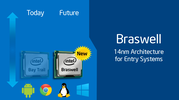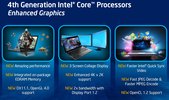Intel HD Graphics 400 (Braswell) vs Intel HD Graphics 4000 vs Intel HD Graphics 4200
Intel HD Graphics 400 (Braswell)
► remove from comparison
Die Intel HD Graphics 400 ist eine in den Low-End-SoCs der Braswell-Serie (z.B. Celeron Serie in 2016) integrierte Grafikeinheit. Sie basiert auf der gleichen Architektur wie die GPU verschiedener Broadwell-Prozessoren (z.B. HD Graphics 5300), bietet allerdings deutlich weniger Shadereinheiten und geringere Taktraten. Die genauen Spezifikationen hängen vom jeweiligen SoC ab: Die schnellste Variante bietet derzeit 12 EUs und maximal 640 MHz.
Anfangs wurde die GPU nur Intel HD Graphics benannt, später als Intel HD Graphics 400 (12 EU Version) und Intel HD Graphics 405 (16 EU Version) bezeichnet.
Anwender müssen sich deshalb insbesondere bei den Celeron-Modellen, die zusätzlich durch die Beschneidung auf nur zwei CPU-Kerne ausgebremst werden, auf ältere und anspruchslose Spiele beschränken. Videos werden dagegen auch in 4K/H.265 flüssig wiedergeben.
Für mehr Benchmarks besuchen sie auch die Seite der Intel HD Graphics (Braswell) GPU, welche Benchmarks der älteren baugleichen 12 und 16 EU Versionen beinhaltet.
Intel HD Graphics 4000
► remove from comparison
Die Intel HD Graphics 4000 (GT2) ist eine Prozessorgrafikkarte in den CPUs der Ivy Bridge Generation (3. Generation von Intel Core z.B. Core i7-3770). Je nach Prozessormodell wird die Intel HD Graphics 4000 unterschiedlich getaktet (und kann auf den unterschiedlich großen Cache zurückgreifen) und bietet daher eine teilweise deutlich geringe Leistung. Weiterhin kann die Taktung durch die Turbo Boost Technologie je nach Anforderung und TDP deutlich erhöht werden. In den schnellen Modellen soll der Basistakt 650 MHz und der Turbo 1.1 bis 1.25 GHz betragen. Die ULV Modelle weisen jedoch einen deutlich geringeren Basistakt auf (Sandy Bridge z.B. 350 MHz).
Im Vergleich zur HD Graphics 3000 der Sandy Bridge Prozessoren, bietet die 4000er einen eigenen Cache, überarbeitete DirectX 11 taugliche Shader (und vier mehr) und soll dadurch bis zu 60% mehr Leistung (3DMark Vantage) zeigen. Weiterhin sollte die GPU auf den gemeinsamen Last Level Cache (Level 3 Cache) des Prozessors zugreifen können. Weiters können die Shader auch für Direct Compute genutzt werden.
Erste Benchmarks positionieren die HD Graphics 4000 (in einem schnellen Desktop Quad-Core) auf dem Level einer Nvidia GeForce GT 330M und dadurch oberhalb der integrierten Prozessorgrafik Radeon HD 6620G. In unserem Unfangreichen Testbericht der HD Graphics 4000 konnte sie sich im schnellen Core i7-3820QM deutlich durchsetzen (6620G 15% langsamer). In den Mittelklassemodellen Core i7-3610QM und einem Dual-Core i5 war sie nur noch knapp schneller. Manchmal ist sogar eine langsame GeForce GT 630M in Reichweite. Gelegenheitsspieler, die bei Bedarf mit einer geringen Auflösung, deaktivierter Kantenglättung und niedrigen Settings leben können, werden daher an der HD Graphics 4000 durchaus Gefallen finden. In den ULV Prozessoren (Core ix-3xx7U) wird eine geringer getaktete Variante eingesetzt. Durch die TDP Beschränkungen kann der Turbo außerdem meistens nicht so hoch takten, wie bei den 35/45 Watt Versionen. Dadurch ist die HD Graphics 4000 hier meist etwa 30% langsamer als in schnellen Quad-Core CPUs.
Eine Besonderheit der Ivy Bride Grafikkerne ist, das nur 4x MSAA von der Hardware unterstützt wird. 2x MSAA wird per Software berechnet und geht durch die 4x MSAA Pipeline. Daher empfiehlt sich der Einsatz des gleich schnellen 4x MSAA.
Auch der integrierte Videodecoder genannt Multi Format Codec Engine (MFX) wurde kräftig überarbeitet und soll nun sogar mehrere 4K Videos parallel dekodieren können (ev nur in den High-End Modellen). DXVA Checker gibt weiterhin die Formate MPEG2, VC1, WMV9 und H264 als unterstütz an. QuickSync zum schnellen Transkodieren von Videos wurde ebenfalls verbessert und soll nun schneller bei gleichzeitig höherer Qualität laufen.
Ebenfalls neu ist die Unterstützung für drei unabhängige Bildschirme (abhängig von der Umsetzung im Notebook eventuell nur zwei gleichzeitige möglich). Bis jetzt waren nur zwei möglich und lediglich die AMD Grafikkarten mit Eyefinity Support bieten mehr als zwei Anschlüsse für Notebooks (jedoch nur mit DisplayPorts). Laut Intel wird DisplayPort in der Version 1.1 unterstützt (daher maximal 2560x1600) und HDMI in 1.4 (in der Praxis 1920x1080, siehe Fokusartikel für 2560x1600).
Der Stromverbrauch ist dank des 22nm Prozesses mit 3D Tri-Gate Technologie relativ gering und nicht einzeln angegeben. Die Notebook-Prozessoren (CPU, GPU, Speichercontroller) sind gesamt auf einen TDP von 18-45 Watt spezifziert.
Intel HD Graphics 4200
► remove from comparison
Die Intel HD Graphics 4200 (GT2) ist eine Low-End Prozessorgrafikkarte in einigen besonders sparsamen ULV-CPUs der Haswell-Generation.
Der Grafikkern wurde im Vergleich zum Intel HD Graphics 4000 der Ivy-Bridge-Generation in verschiedenen Punkten weiterentwickelt. So unterstützt die GPU nun mit DirectX 11.1, OpenCL 1.2 und OpenGL 4.0 alle wichtigen aktuellen Standards. Auch ein verbesserter Decoder für 4K-Videos sowie ein überarbeiteter Quick-Sync-Encoder sind mit an Bord.
Die Performance der HD Graphics 4200 liegt im Schnitt noch deutlich unter der HD 4600 und HD 4400, da die GPU für ULV-Modelle der Y-Serie (11,5 Watt TDP) mit sehr niedriger Taktrate vorgesehen ist. Insgesamt entspricht die Leistung trotz der geringeren Kernfrequenz in etwa der HD 4000 der Ivy-Bridge-Generation. Neben architektonischen Verbesserungen wird dies vor allem über eine gesteigerte Zahl an Ausführungseinheiten erreicht: Die GT2-Ausbaustufe integriert nun 20 (HD 4000: 16) der sogenannten EUs.
In einfachen Spielen wie Anno 2070 oder Counter Strike: Global Offensive genügt die Performance, um niedrige Einstellungen und 1.024 x 768 Pixel zu bewältigen. Viele aktuelle Titel wie Battlefield 4 sind hingegen selbst bei minimaler grafischer Qualität nicht flüssig spielbar. Detaillierte Benchmarks können sie weiter unten auf dieser Seite finden.
Der Stromverbrauch ist dank des 22-Nanometer-Prozesses mit Tri-Gate-Transistoren relativ gering und wird dynamisch vom TDP-Budget des gesamten Chips abgezweigt. Zusätzlich zur TDP von 11,5 Watt gibt Intel auch eine durchschnittliche Leistungsaufnahme (SDP) an, die je nach Modell bei 4,5 oder 6 Watt liegt.
Weitere Details zur Grafikkartenarchitektur der Haswell Generation finden Sie in unserem Artikel zur Haswell-Architektur sowie dem Bericht vom IDF 2012.
| Intel HD Graphics 400 (Braswell) | Intel HD Graphics 4000 | Intel HD Graphics 4200 | ||||||||||||||||||||||||||||||||||||||||||||||||||||||||||||||||||||||||||||||||||||||||||||||||||||||||||||||||||||||||||||||||||||||||||||||||||||||||||||||||||||||||||||||||||||||||||||||||||||||||||||||||
| HD Graphics Serie |
|
|
| |||||||||||||||||||||||||||||||||||||||||||||||||||||||||||||||||||||||||||||||||||||||||||||||||||||||||||||||||||||||||||||||||||||||||||||||||||||||||||||||||||||||||||||||||||||||||||||||||||||||||||||||
| Codename | Braswell | Ivy Bridge | Haswell GT2 | |||||||||||||||||||||||||||||||||||||||||||||||||||||||||||||||||||||||||||||||||||||||||||||||||||||||||||||||||||||||||||||||||||||||||||||||||||||||||||||||||||||||||||||||||||||||||||||||||||||||||||||||
| Architektur | Gen. 8 | Gen. 7 Ivy Bridge | Gen. 7.5 Haswell | |||||||||||||||||||||||||||||||||||||||||||||||||||||||||||||||||||||||||||||||||||||||||||||||||||||||||||||||||||||||||||||||||||||||||||||||||||||||||||||||||||||||||||||||||||||||||||||||||||||||||||||||
| Pipelines | 12 - unified | 16 - unified | 20 - unified | |||||||||||||||||||||||||||||||||||||||||||||||||||||||||||||||||||||||||||||||||||||||||||||||||||||||||||||||||||||||||||||||||||||||||||||||||||||||||||||||||||||||||||||||||||||||||||||||||||||||||||||||
| Kerntakt | 320 - 640 (Boost) MHz | 350 - 1350 (Boost) MHz | 200 - 850 (Boost) MHz | |||||||||||||||||||||||||||||||||||||||||||||||||||||||||||||||||||||||||||||||||||||||||||||||||||||||||||||||||||||||||||||||||||||||||||||||||||||||||||||||||||||||||||||||||||||||||||||||||||||||||||||||
| Speicherbandbreite | 64/128 Bit | 64/128 Bit | 64/128 Bit | |||||||||||||||||||||||||||||||||||||||||||||||||||||||||||||||||||||||||||||||||||||||||||||||||||||||||||||||||||||||||||||||||||||||||||||||||||||||||||||||||||||||||||||||||||||||||||||||||||||||||||||||
| Shared Memory | ja | ja | ja | |||||||||||||||||||||||||||||||||||||||||||||||||||||||||||||||||||||||||||||||||||||||||||||||||||||||||||||||||||||||||||||||||||||||||||||||||||||||||||||||||||||||||||||||||||||||||||||||||||||||||||||||
| API | DirectX 11.2, Shader 5.0 | DirectX 11, Shader 5.0, OpenGL 3.1 | DirectX 11.1, Shader 5.0, OpenGL 4.0 | |||||||||||||||||||||||||||||||||||||||||||||||||||||||||||||||||||||||||||||||||||||||||||||||||||||||||||||||||||||||||||||||||||||||||||||||||||||||||||||||||||||||||||||||||||||||||||||||||||||||||||||||
| Herstellungsprozess | 14 nm | 22 nm | 22 nm | |||||||||||||||||||||||||||||||||||||||||||||||||||||||||||||||||||||||||||||||||||||||||||||||||||||||||||||||||||||||||||||||||||||||||||||||||||||||||||||||||||||||||||||||||||||||||||||||||||||||||||||||
| Erscheinungsdatum | 01.04.2016 | 23.03.2011 | 05.06.2013 | |||||||||||||||||||||||||||||||||||||||||||||||||||||||||||||||||||||||||||||||||||||||||||||||||||||||||||||||||||||||||||||||||||||||||||||||||||||||||||||||||||||||||||||||||||||||||||||||||||||||||||||||
| Features | QuickSync | QuickSync |
|
|
| ||||||||||||||||||||||||||||||||||||||||||||||||||||||||||||||||


 Deutsch
Deutsch English
English Español
Español Français
Français Italiano
Italiano Nederlands
Nederlands Polski
Polski Português
Português Русский
Русский Türkçe
Türkçe Svenska
Svenska Chinese
Chinese Magyar
Magyar

























































































































